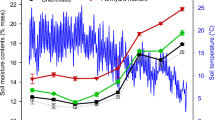Summary
CO2 evolution, fungal biomass and microbial population of two maize field soils differing in agricultural systemsviz., permanent agriculture on plain lands in valleys and ‘slash and burn’ type of shifting agriculture, were estimated at monthly intervals for one crop cycle. The results showed significant positive correlation among CO2 evolution, fungal biomass, microbial population, organic C and total N. There was significant positive correlation between bacterial population and moisture content in both the agricultural systems. Microbial population and CO2 evolution were always higher in the soils of permanent agriculture as compared to that of ‘slash and burn’ type of shifting agriculture.
Similar content being viewed by others
References
Anderson J M 1973 Carbon-dioxide evolution from two temperate deciduous woodland soils. J. Ecol. 10, 361–78.
Allen S E (Ed.) 1974 Chemical analysis of ecological materials. Blackwell Scientific Publications, Oxford pp 565.
Bunnel F L, Tait D E N, Flanagan P W and Cleve M V 1977 Microbial respiration and substrate weight loss. 1. A general model of the influence of abiotic variables. Soil Biol. Biochem. 9, 33–40.
Cutler D W, Crump L M and Sandon H 1922 A quantitative investigation of the bacterial and protozoan fauna. Philosophical Transactions of the Royal Society Series B 211, 317–347.
Cleve K V, Coyne P I, Goodwin E, Johnson C and Kelley M 1979 A comparison of four methods for measuring respiration in organic material. Soil Biol. Biochem. 2, 237–246.
Douglas L A and Tedrew J C F 1959 Organic matter decomposition rates in Arctic soils, Soil Sci. 88, 305–12.
Dowding P and Widden P 1974 Some relationships between fungi and their environment in Tundra regions.In Soil Organisms and Decomposition in Tundra. Eds A J Holding, O W Heal, S F Maclean Jr and P W Flanagan. pp 123–150. Tundra Biome Steering Committee, Stockholm, Sweden.
Gupta S R and Singh J S 1981 Soil respiration in a tropical grasslands. Soil Biol. Biochem. 13, 261–268.
Jones P C T and Mollison J E 1948 A technique for the quantitative estimation of soil microorganisms. J. Gen. Microbiol. 2, 54–69.
Johnson L F and Curl E A 1972 Methods for the Research on Ecology of soil borne plant pathogens (Minneopolis Burges Publication Co) pp 247.
Kucera C L and Kirkham D R 1971 Soil respiration studies in tall grass prairie in Missouri. Ecology 52, 912–15.
Martin J P 1950 Use of acid, rose bengal and streptomycin in the plate method for estimation of soil fungi. Soil Sci. 69, 215–232.
Macfadyen A 1973 Inhibitory effects of carbon dioxide on microbial activity in soil. Pedobiologia 13, 140–149.
Mikola J and Komppula J 1981 Respiratory activity of milled peat: a rapid method of measurement and observation on the effects of moisture, temperature, pH and peat quality. Soil Sci. 131, 156–162.
Roberge M R and Knowles R 1966 Microbial populations in a black spruce humus fertilized with urea. Woodland Research Index. Pulp paper Research Institute, Canada 180, pp 27.
Reiners W A 1968 Carbon dioxide evolution from the floor of three Minnesota forests. Ecology 39, 471–83.
Ross D J 1973 Some enzymes and respiratory activities of tropical soils from New Hebrides, Soil Biol. Biochem. 5, 559–567.
Ramakrishnan P S and Toky O P 1981 Soil nutrient status of hill agro-ecosystems and recovery pattern after slash and burn agriculture (jhum) in North-Eastern India. Plant and Soil 60, 41–64.
Schalin I 1967 On the effect of nitrogen fertilization on the bacteria and micro-fungi in humus layer, Silva Fenn 3, 1–12.
Stotzky G 1960 A simple method for the determination of the respiratory quotient of soils. Can. Microbiol. 6, 439–452.
Soderstrom B 1977 Vital staining of fungi in pure cultures and in soil with fluorescein diacetate. Soil Biol. Biochem. 9, 59–63.
Singh J S and Gupta S R 1977 Plant decomposition and soil respiration in terrestrial ecosystems. Bot. Rev. 43, 449–528.
Soderstrom B E 1979 Seasonal fluctuations of active fungal biomass in horizons of a podzolized pine forest soil in Central Sweden. Soil Biol. Biochem. 11, 149–154.
Thomas A, Nicholas D P and Parkinson D 1965 Modifications of the agar-film technique for assaying lengths of mycelium in soil. Nature, London 205, 105.
Tesarova M and Glosa J 1976 Total carbon dioxide output from alluvial soils with two types of grassland communities. Pedobiologia 16, 364–72.
Tate R L and Richard T R 1980 Variation in microbial activity in histosols and its relationship to soil moisture. Appl. Environm. Microbiol. 40, 313–317.
Upadhyaya S D, Siddiqui S A and Singh V P 1981 Seasonal variation in soil respiration of certain tropical grassland communities. Trop. Ecol. 22, 157–161.
Waksman J H 1922 A method of counting of the numbers of fungi in the soil. J. Bot. 7, 339–341.
Walkley A and Black I A 1934 An examination of the Degtjaredd method for determining soil organic matter and a proposed modification of the chromic acid titration method. Soil Sci. 37, 29–38.
Warcup J H 1950 The soil plate method for isolation of fungi from soils. Nature, London 166, 117–118.
Witkamp M 1966 Rates of carbon dioxide evolution from the forest floor. Ecology 47, 492–494.
Wagner G M 1975 Microbial growth and carbon turnover.In Soil Biochemistry. Eds E A Paul and A D Mclaren. pp 269–305, Marcel Dekker, New York.
Author information
Authors and Affiliations
Rights and permissions
About this article
Cite this article
Dkhar, M.S., Mishra, R.R. Microbial population, fungal biomass and CO2 evolution in maize (Zea mays L.) field soils. Plant Soil 99, 277–283 (1987). https://doi.org/10.1007/BF02370874
Received:
Revised:
Issue Date:
DOI: https://doi.org/10.1007/BF02370874




